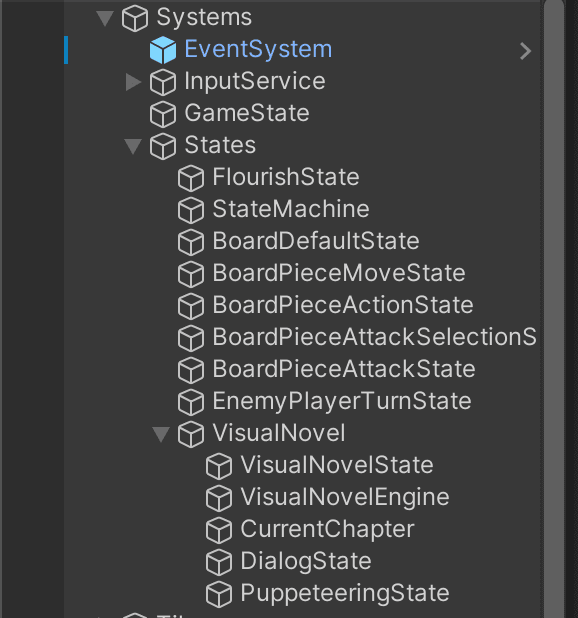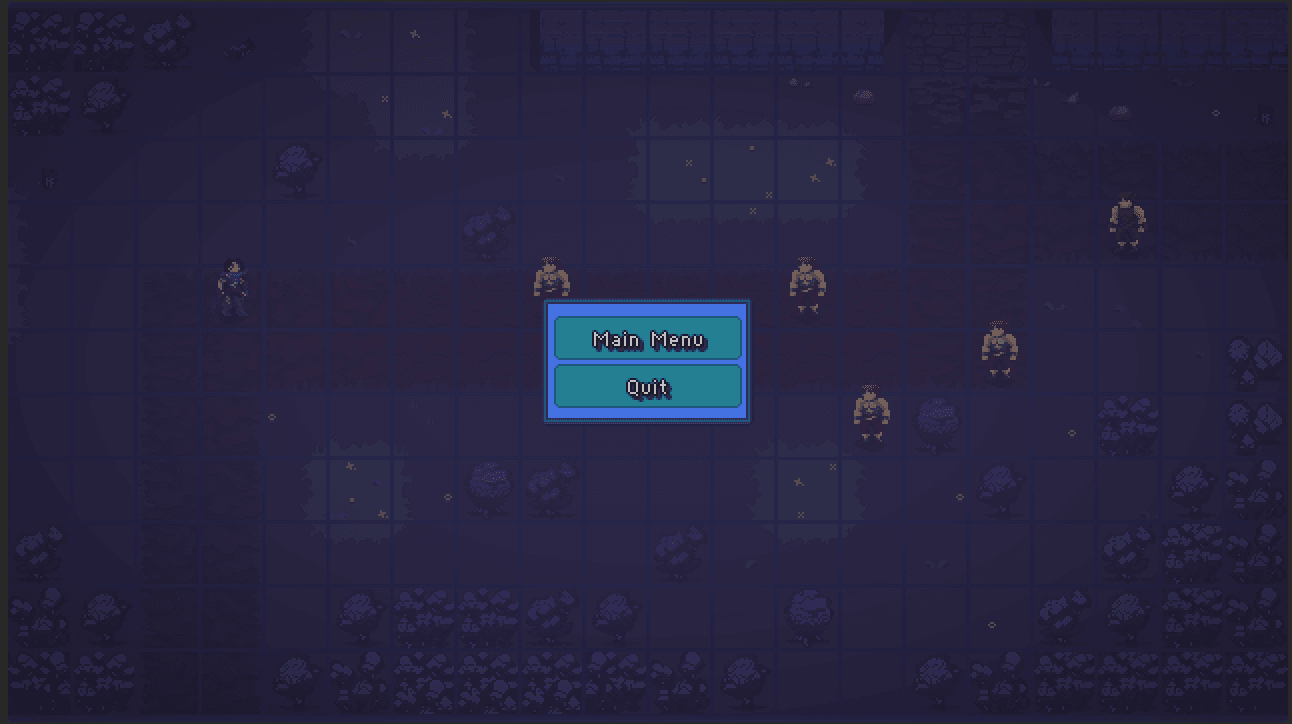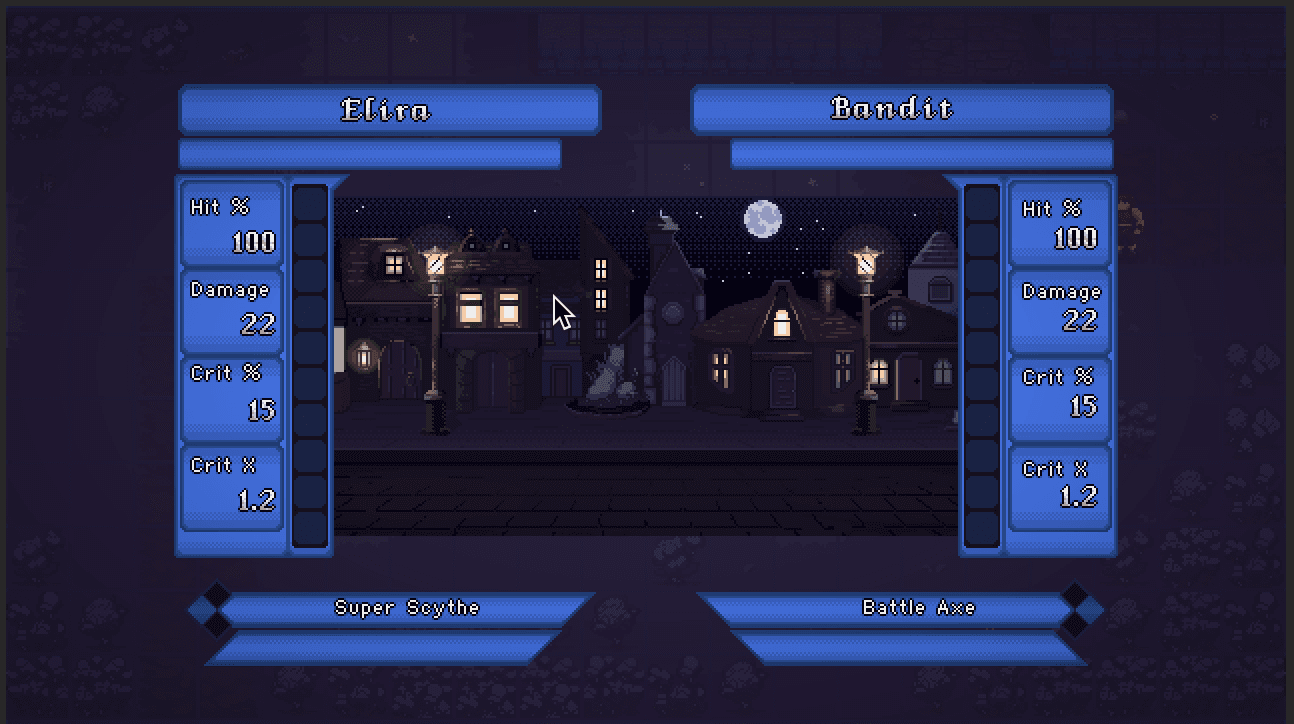- Published on
Advent of the Reaper Entry Three
State of the Adventinalia
At this point in my Unity learning path, I feel decently comfortable designing small games. The VR arcade, Eddie's tour. Until now I haven't needed anything too complex. I had to take a step back with the main Advent battle scene.
Think about what the tactical RPG needs to do.
- Choose a turn
- Pause and wait for the character to select a character
- If a character is selected, display movement
- once movement is chosen, pop up a menu allowing confirmation (among other things)
- Ask if they'd like to attack, if so, which cell to attack?
- Finally, display the attack vignette to resolve combat and return to #1/#2
That's for the player's turn! If it's the AIs turn, we walk through a subset of those items on a loop before returning input control back to the player. Also, we need to allow a player to roll back to a previous step (cancel selection).
I did some research and arrived at a solution similar to a few I've seen, hoping to strike the balance between hacky and overly abstract.

I decided to introduce the idea of State. There is an overall StateMachine that keeps track of which states are active and which are overlaid by what (via a Priority field).
Every State is also a MonoBehavior on a GameObject - essentially a bunch of singletons with global scope, but I can handle the global state drawback by encapsulation and access control levers.
Let's look at StateMachine first. StateMachine is in charge of keeping a reference all the game states, and providing utilities to determine which is the active state, etc. Here is an example utility method -
public State PriorityActiveState()
{
return ActiveStates().MaxBy(a => a.Priority).First();
}
This is used to select the active state (for example, other decoupled UI components may hide themselves if the active state is the battle vignette).
GameState holds the most important state for the battle map - the Set of board pieces, the map tile information, who's turn it is and how many turns has elapsed, that sort of thing. It is in charge of keeping track of turns. It also holds an instance to the VisualNovelEngine which is a good topic for another post :)
Finally, the majority of the rest of the States in the folder implement the following interface / class combination -
namespace States
{
public interface State
{
int Priority { get; }
bool Active { get; set; }
List<State> IsOverlaidBy { get; set; }
void HandlePrimaryAction();
void HandleSecondaryAction();
void HandleMousePosition(Vector2 newPos);
//TODO left/right/up/down
}
public interface State<in T> : State
{
void Activate(T t);
void Deactivate();
}
public abstract class BaseState<T> : MonoBehaviour, State<T> where T : class
{
public T DisplayProps { get; private set; }
public virtual void Activate(T t)
{
DisplayProps = t;
Active = true;
}
public virtual void Deactivate()
{
DisplayProps = null;
Active = false;
}
public abstract int Priority { get; }
public abstract bool Active { get; set; }
public abstract List<State> IsOverlaidBy { get; set; }
public abstract void HandlePrimaryAction();
public abstract void HandleSecondaryAction();
public abstract void HandleMousePosition(Vector2 newPos);
}
}
The generic T exists so that when a State is Activated, any typed properties can be passed in to be used for the rest of the lifecycle of the State. Sure it could be more tightly coupled to GameState for example but this lets them exist more independently.
The big idea here - See the Handle* methods. This allows a state - critically - to be in charge of capturing user input. The priority active state should be the one to capture and interpret input. For now, we're just focused on keyboard and mouse, but later on this can be used to implement left/right/up/down with a controller or phone (for a phone, I'd render buttons on the phone display).
As a very simple example, here's how the Options menu was implemented. When the player presses escape, we set the escape menu state active and overlay a slight sneezeguard and the options menu UI.

namespace States
{
public class OptionsMenu : MonoBehaviour, State
{
public int Priority => 100; // should be the prio over everything!
public bool Active { get; set; }
public List<State> IsOverlaidBy { get; set; }
public GameObject menu;
public Sneezeguard sneezeguard;
public void HandlePrimaryAction()
{
// do nothing
// see note at the end - UI buttons handle their own onClick!
}
public void ShowMenu()
{
menu.SetActive(true);
sneezeguard.Show();
}
public void HideMenu()
{
menu.SetActive(false);
sneezeguard.Hide();
}
public void HandleSecondaryAction()
{
// do nothing
}
public void HandleMousePosition(Vector2 newPos)
{
// do nothing
}
}
}
One more simple example - the State that handles playing the battle vignette! When the vignette runs, we don't let the player interact until it's over, so handling input is really easy :) This time however, we actually use the generic.

namespace States
{
public class AttackDisplayProps
{
public BoardPiece Ally { get; set; }
public BoardPiece Enemy { get; set; }
}
public class BoardPieceAttackState : BaseState<AttackDisplayProps>
{
public override int Priority => 1;
public override bool Active { get; set; }
public override List<State> IsOverlaidBy { get; set; }
public AttackFlourish attackFlourish;
public StateMachine stateMachine;
public override void Activate(AttackDisplayProps t)
{
base.Activate(t);
StartCoroutine(DoAttack(t.Ally, t.Enemy));
}
public IEnumerator DoAttack(BoardPiece ally, BoardPiece enemy)
{
var instance = Instantiate(attackFlourish, attackFlourish.transform.parent, true);
yield return instance.AttackAnimation();
stateMachine.RequestDeactivateState(this);
Destroy(instance.gameObject);
ally.TakeTurn();
}
public override void HandlePrimaryAction()
{
// do nothing
}
public override void HandleSecondaryAction()
{
// do nothing
}
public override void HandleMousePosition(Vector2 newPos)
{
// do nothing
}
}
}
One somewhat confusing result of this system is that primary/secondary actions are captured by the State when there isn't something that captures it first. UI buttons can nab the onClick before the State does. This seems okay because if a button is present - the button should decide if it's clickable and what happens when it is clicked, but still seems like a bit of a loophole from the view of the State object.
Regardless, It's a nice little methodology that strikes a good balance between maintainability and overwrought abstraction. My next article will talk about the VisualNovelEngine and its corresponding States - a much more complicated example! Stay tuned!
